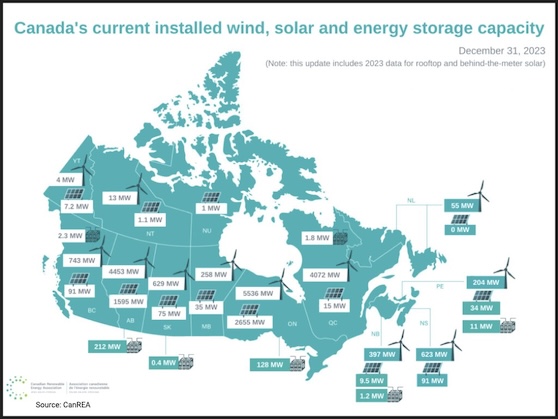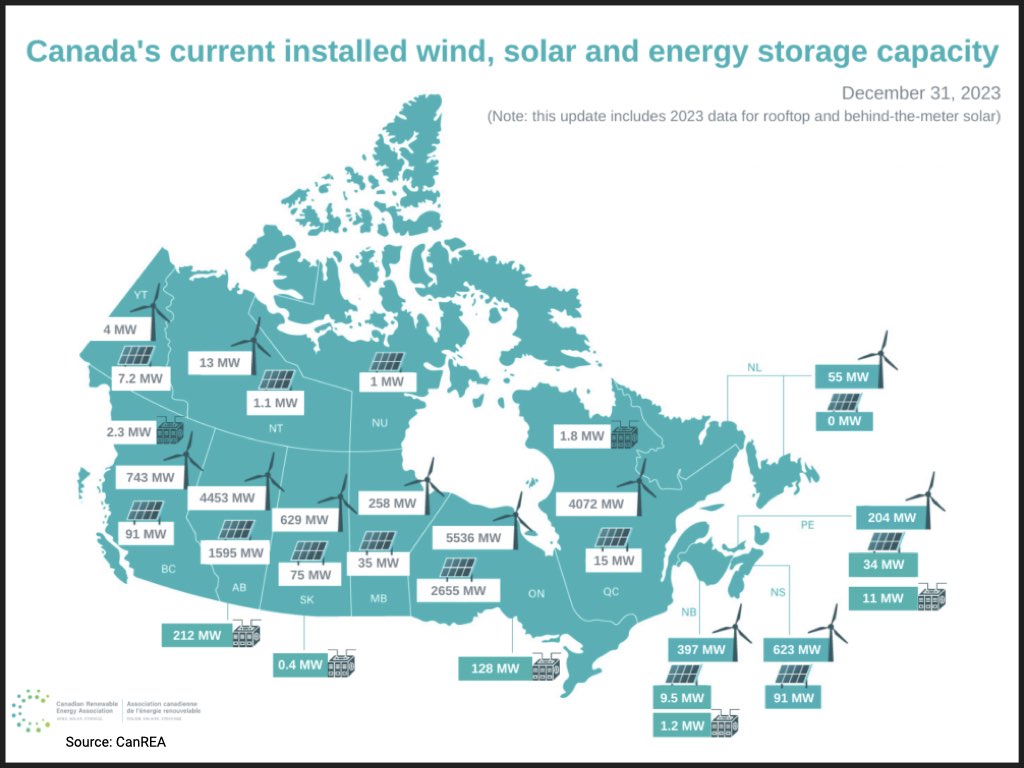
Cleantech
Features
News
News
Cleantech
Energy & Power
Energy Storage
Generation
News
Renewables
Despite adding 2.3 GW of renewables/storage, CanREA says we must “increase the pace of build-out”
February 12, 2024 | By Anthony Capkun
 Larger image below
Larger image below February 12, 2024 – Canada’s wind, solar, and energy storage sectors grew by 11.2% in 2023, according to industry data released by the Canadian Renewable Energy Association (CanREA).
This year’s greatest success stories were found in Atlantic Canada, the North, and Alberta. Other provinces saw no growth in their wind, solar, or energy storage sectors in 2023. CanREA says this is due to their lack of centralized procurements and corporate power purchase agreement (PPA) offerings.
The industry added 2.3 GW of new capacity in 2023, including more than 1.7 GW of utility-scale wind, nearly 360 MW of utility-scale solar, 86 MW of onsite (rooftop and behind-the-meter) solar, and 140 MW/190 MWh of energy storage.
Canada now has a total installed capacity of more than 21.9 GW, including 20.4 GW of utility-scale wind and solar energy, 1.2 GW of onsite solar, and 356 MW/539 MWh of energy storage nationwide.
“Canada’s wind, solar, and energy storage industry had a relatively good year in 2023, but it fell short of the trajectory needed to meet net-zero targets,” said Vittoria Bellissimo, CanREA president and CEO. “What is needed is more geographic diversity. We need to increase the pace of build-out, and we need to see deployment in all provinces and territories.”
REGIONAL BREAKDOWN

Alberta accounted for 92% of Canada’s overall growth in renewables and energy storage capacity in 2023. The province added 1.7 GW of installed capacity, and now has a total of 5.8 GW of renewable energy generation, as well as 212 MW/260 MWh energy storage capacity.
However, the pause on approvals announced by the Alberta government in August—alongside the investor uncertainty it creates—will have impacts into 2025 and beyond. CanREA is tracking 8.3 GW of projects under development in Alberta. Of these, 3.9 GW of projects had the potential to come online in 2025, along with a further 4.4 GW of proposed projects with later commissioning dates, which are all now at risk.
Wind made gains in Yukon, moving from 0.2 MW to 4 MW total. The Northwest Territories added 3.2 MW in Inuvik (Enercon).
In Saskatchewan, CanREA is tracking 200 MW of projects under construction, 800 MW of wind and solar projects, and a single 20-MW battery site with 20 MWh capacity (all currently in advanced stages of development), as well as 350 MW of wind projects in the proposal stage.
Saskatchewan’s longer-term (procurement) outlook includes 600 MW of wind and solar in south-central Saskatchewan, expected to be in service by 2027, up to 1 GW wind and solar in the southwest by 2030, and 1 GW of wind and solar for 2030-2035.
At this time, the current total installed capacity in Saskatchewan remains the same as last year.
Ontario’s installed capacity is still the largest in Canada, at more than 7.5 GW (5.5 wind, nearly 2 GW solar, more than 100 MW storage). This total is expected to increase, as the province invests in energy storage.
CanREA is tracking 429 MW of storage projects that are already in advanced development, and another 407 MW in proposed energy storage projects.
There is no new wind or solar development expected in the short term (2024-2025) in Ontario, but the longer-term outlook includes up to 2 GW of new wind and solar by 2030-2031, and up to 3 GW of additional new wind and solar by 2034.
Quebec currently has the third-highest installed capacity of wind and solar energy and energy storage in Canada, at more than 4 GW (nearly all wind, though). While this total did not increase in 2023, there is opportunity for growth in the long term.
Hydro-Quebec intends to triple windpower generation by integrating more than 8 GW of wind capacity into the grid by 2030, and two more by 2035.
It also intends to establish the province’s first pumped-storage facility with a 1-GW capacity, and to facilitate the installation of solar panels on the homes of more than 125,000 customers by 2035.
British Columbia currently has 746 MW of capacity (742 MW wind, 2 MW solar, 2 MW storage) and, in future, BC Hydro plans to acquire 3,000 GWh of renewable energy per year.
Parts of Atlantic Canada saw growth in 2023, with New Brunswick adding 42 MW of wind and Prince Edward Island adding 31 MW of utility-scale solar, as well as some energy storage.
CanREA is tracking a total of 296 MW of projects in advanced development across the Atlantic region (280 MW onshore wind, while the rest includes both utility-scale solar and energy storage).
New Brunswick aims to increase renewables five-fold by 2035, adding 1.4 GW of new windpower, 0.2 GW of grid-scale solar power, an additional 0.1 GW of energy storage, and 0.3 GW of onsite solar.
Nova Scotia aims to add more than 1 GW of new wind capacity, more than 300 MW of solar, and 300 MW to 400 MW of battery storage by 2030, with the potential for offshore wind post-2030.
Print this page